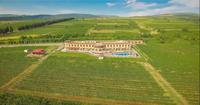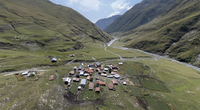Nestled within the arid expanses of the Kakheti region, in the easternmost fringes of Georgia, you'll find a humble settlement known as Udabno, a name which intriguingly translates to 'Desert' in Georgian. Perched at an elevation of 750 meters (approximately 2460 feet) above sea level and a mere 45 kilometers (about 28 miles) from Sagarejo municipality, this village isn't just a dot on the map; it's a vibrant community with an intriguing story.
While its origins may be traced back to the mid-1980s, during the era of Soviet influence, Udabno's distinctive character emanates not from its relative youth, but from the singular heritage of its residents. The village was intentionally established as a new home for eco-migrants from the rugged, mountainous region of Svaneti. These proud people, rich in cultural heritage, brought with them their unique way of life, thus birthing a microcosm that warrants exploration.
The village's near solitude and its proximity to the historic David Gareja monastery complex add a touch of the mystic to its charm. This enclave of religious heritage, quietly observing the passage of time, is one of Georgia's most iconic landmarks and a compelling reason why many might find themselves on the road leading through Udabno.
Though initially conceived as a haven for the displaced, the narrative of Udabno has transformed over the years. Today, this once almost forgotten desert village stands as a testament to the resilience of the Svan people and the captivating allure of the Georgian desert.
From Tbilisi, the pulsating heart of Georgia, a 50-kilometer (around 31 miles) journey through time and space brings you to this quaint community. The trip promises a sensory exploration of a world less known, less crowded, yet overflowing with an authenticity that captures the spirit of Georgia.
So, whether it's the lure of the historic monastery, the captivating landscapes, or the charm of the Svan people and their culture, Udabno invites you to discover a slice of Georgia that's as complex and rich as the desert sands upon which it stands.



 Kumelaurta
Kumelaurta
 Dochu
Dochu
 Shenako
Shenako
 Sasadilo
Sasadilo
 Telavi
Telavi
 Dedoplistskaro
Dedoplistskaro
 Kvareli
Kvareli
 Akhasheni
Akhasheni
 Gogrulta
Gogrulta
 Velistsikhe
Velistsikhe
 Laliskhuri
Laliskhuri
 Gurjaani
Gurjaani
 Bochorna
Bochorna
 Omalo
Omalo
 Akhmeta
Akhmeta
 Diklo
Diklo
 Dartlo
Dartlo
 Girevi
Girevi
 Sighnaghi
Sighnaghi
 Alvani
Alvani
 Lagodekhi
Lagodekhi
 Tsnori
Tsnori